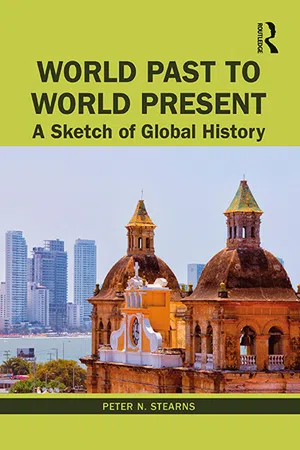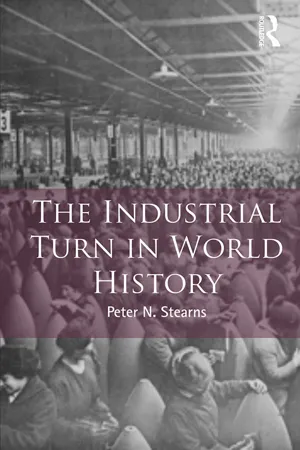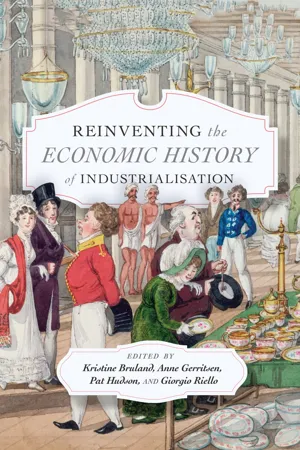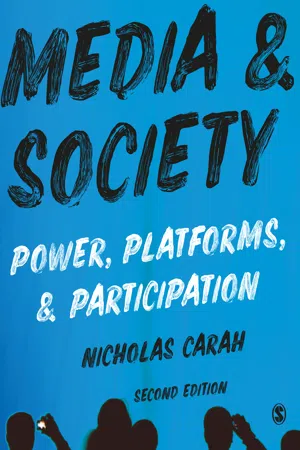History
The Industrial Age
The Industrial Age, also known as the Industrial Revolution, was a period of significant technological, economic, and social change that began in the late 18th century. It marked the transition from agrarian and handcraft-based economies to industrial and machine-based manufacturing. Key developments included the invention of steam power, the mechanization of production processes, and the rise of factories, leading to profound shifts in labor, urbanization, and global trade.
Written by Perlego with AI-assistance
Related key terms
Related key terms
1 of 4
Related key terms
1 of 3
5 Key excerpts on "The Industrial Age"
- eBook - ePub
World Past to World Present
A Sketch of Global History
- Peter N. Stearns(Author)
- 2021(Publication Date)
- Routledge(Publisher)
Part IIThe Industrial Age
DOI: 10.4324/9781003198185-10Passage contains an image
9 The Nature of Industrial SocietyDOI: 10.4324/9781003198185-11There is little question that the most important single development in world history over the past 300 years was, and is, the industrial revolution and its ramifications, both within major societies and in the relationships among these societies. This chapter focuses on what this was all about, and how industrialization is still requiring adaptations even today.A tension exists between the importance of the industrial revolution and the challenge of fitting it into a historical survey. For while industrialization begins at an identifiable time and place – Britain, late 18th century – it ultimately became a global phenomenon, spread out over more than two centuries. This complicates placement in a chronological narrative, which is why it is useful to extract industrialization for separate examination before returning to a more standard account, beginning with the late 18th-/19th-century period itself.A sense of regional stages may help clarify the global angle: initial industrialization centered on Britain, then the West more generally, including the United States. Stage two opened by the end of the 19th century, embracing Russia and Japan. A further expansion involved the Pacific Rim, by the 1960s. Then the end of the 20th century saw the process clearly extend to China – quickly one of the great contemporary industrial powerhouses, India, Turkey, Brazil, Mexico: the recent list is a long one.The main point, ultimately, is the global involvement in industrial transformation. For what is involved here is a major alteration of a host of human behaviors, comparable only to the replacement of hunting and gathering with agriculture so many centuries in the past. (There’s an obvious invitation here to compare the patterns discussed in this chapter with those described in Chapter 2. - eBook - ePub
- Peter Stearns(Author)
- 2016(Publication Date)
- Routledge(Publisher)
2 Building Industrial SocietyThe Industrial Revolution
The foundations of industrial society were set by the Industrial Revolution, along with efforts to establish conditions that would generate an industrial revolution. While the main focus of this book rests on how industrial society has departed from many of the core characteristics of the Agricultural Age, it is essential to grasp the factors that set change in motion. This chapter focuses on the nature of the Industrial Revolution as a process and the causes that pushed it forward.After a brief discussion of timing, we will begin with a definition of the revolution itself, centering on fairly dramatic new technology, particularly in manufacturing and transportation, and the growing reliance on fossil fuel power—initially coal, later petroleum as well—and on changes in the organization of work.The initial definition must also capture two kinds of complexity. First, industrialization, while producing rapid change—for example, in the growth of cities—was not an overnight process. Historically, it takes 60 to 80 years to move from the early stages of installing new equipment and factory apparatus to anything like a substantial transformation of the economy as a whole. More traditional sectors, both in agriculture and in urban crafts, hang on for a long time. And it takes even longer, as we will see, for some of the larger implications of industrialization to work themselves out in society as a whole—indeed, arguably, even the most advanced industrial societies today are still refining some aspects of this process.The second complexity, which attaches to basic definitions, involves the huge strain that the Industrial Revolution placed on many of the individuals involved—factory workers most obviously, but others as well. Some pressures would ultimately ease as industrial forms matured and as people became more accustomed to the changes involved; some, however, linger still—as in the widespread concern about stress or anxiety in many forms of modern work. - eBook - ePub
- Daniel Chirot(Author)
- 2011(Publication Date)
- SAGE Publications, Inc(Publisher)
Emphasizing the purely material aspects of change in the modern era can be misleading. If most people are better off than their ancestors, this does not mean that problems associated with modernization do not exist. On the contrary, the rapidity of change has had a wrenching effect on all the societies affected. Even in the most advanced parts of Europe, these changes have occurred only in the past six to eight generations, and throughout most of the world, only in the past two to three generations. Thus, human societies have not yet had time to absorb the consequences of all these transformations or to find workable solutions to all the problems they have produced. After all, it took 2,000 years for agrarian-state societies to work out religious and ideological solutions to the moral problems raised by the changes they brought about. It will take at least a few centuries for modern industrial social systems to do the same.Furthermore, the intellectual, religious, and political elites who produce the ideas through which human societies interpret their world have been far from universally happy about modernization. Many have devoted their lives over the past 200 years to resisting modernization, denigrating it, and proposing ways of reorganizing societies to nullify the effects of capitalism, markets, and industrialization. If material progress throughout the modern era had always been smooth, without periodic crises, and if it had been evenly distributed, so that all parts of every society had gained at an equal rate, these resisting and protesting elites would have had few followers. But social change in the modern era has been anything but smooth and evenly distributed.It is to the problems raised by modernization, and some new, or returned negative aspects that we must now turn in order to better understand social and cultural change in the past two centuries.Industrial Cycles
The Industrial Revolution is usually thought to have begun in England in about 1780. Though no economic change can be dated precisely, it is certain that between 1760 and 1800, a major change took place. Wool and linen cloth manufacturing were vastly surpassed by the production of manufactured cotton cloth, and this cotton cloth started to be made in factories that were more mechanized than any large-scale manufacturing process had ever been before. In the 1750s to 1770s, England, which cannot grow cotton because it is too cold, imported an average of 1,000 to 3,000 metric tons of cotton per year, mostly from India. By 1790, that number shot up to 14,000 tons per year; by 1800 to 24,000; by 1810 to 56,000; and by 1840 to 208,000 tons. By 1840, the South in the United States had become the world’s major producer of cotton. The spectacular inventiveness of entrepreneurs in England yielded a long set of mechanical improvements that allowed cloth to be made faster, better, and more cheaply than ever before in human history, so that English cloth exports gained markets all over the world. Other advanced European countries, and eventually the United States, imitated England’s technology, but it took decades to catch up. During this time, the English combined their advantage in cloth making with their older skills in shipping and long-distance trade to become by far the dominant economic power in the world. None of this would have been possible if private entrepreneurship had not been considered legitimate or if profits had been restricted for social reasons. - Kristine Bruland, Anne Gerritsen, Pat Hudson, Giorgio Riello(Authors)
- 2020(Publication Date)
- McGill-Queen's University Press(Publisher)
PART ONE The Age of Manufactures: Knowledge, Making, and the Organisation of ProductionPassage contains an image 1 Could Artisans Have Caused the Industrial Revolution?
Morgan Kelly, Joel Mokyr, and Cormac Ó GrádaIntroductionMaxine Berg’s Age of Manufactures, 1700–1820 (1985; 1994) is one of the finest books ever written about the Industrial Revolution.1 It combines the best elements of economic and social history with the humanist’s instincts for what technological change meant for different groups, including women, children, and a variety of occupations and members of the working class. It rightly criticised the limited view of the Industrial Revolution as confined to a set of glamour industries such as cotton and iron, where expansion was sudden and dramatic. It questioned then-conventional interpretations of the Industrial Revolution which highlighted the roles of resource endowments and agricultural productivity, and located British distinctiveness instead in ‘the extraordinary industry and inventiveness of her manufacturing people’.2 It stressed that progress during the Industrial Revolution took place across a wide array of manufacturing industries, much of it in small workshops in which most of the metal trades industries were located. Berg rightly insisted that the macroeconomic approach to economic change must be supplemented with industry studies on a more regional level.3- eBook - ePub
Media and Society
Power, Platforms, and Participation
- Nicholas Carah(Author)
- 2021(Publication Date)
- SAGE Publications Ltd(Publisher)
3 The Industrial Production of Meaning During the twentieth century the production of meaning became industrialized.- * How did the organization and production of meaning change during the twentieth century?
- * How did we begin to understand the relationship between the industrial production of meaning and power?
- * How have digital technologies changed the production of culture?
- * What are the differences between different media and cultural institutions?
In this chapter we:- Examine the industrialization of communication in the twentieth century
- Examine some key theories of the power of industrialized meaning making from the twentieth century
- Propose that the culture industry is central to controlling the production and circulation of meaning in society, and therefore has material consequences for the kind of society we live in, the way we live and the way we relate to each other
- Explore the role professionalized and industrialized communication plays in forming and maintaining power relationships
- Examine how the industrial production of culture has endured and changed in the shift from the mass to the network and platform eras.
Media and the mass society
Media institutions and technologies, as we know them today, emerge as part of the formation of mass societies (Thompson 1995). Mass societies were born with the industrial revolution, when large factories and machinery dramatically increased the production of material goods. The industrial revolution, which took place from the late 1700s onwards, is the historical process through which agrarian societies became predominantly industrial and urban. The industrial revolution drew an enormous workforce into cities for the first time. These cities were enormous, filthy, disorganized and dangerous. Never before had the institutions and infrastructure been built for so many people to live in such close proximity to each other. Institutions had to be developed for managing these densely packed populations: schools, hospitals, sanitation, postal systems, welfare and media. An institution is an entity like a factory, school, hospital, prison, government department or a media corporation. These institutions produced new ways of life and new kinds of people. Institutions are characterized by well-organized and structured relationships. Rules and procedures govern the behaviour of people to produce dependable outcomes, and even predictable kinds of people. For instance, schools teach a set curriculum to produce graduates who have a standard set of ideas in their mind and therefore behave in similar ways.
Index pages curate the most relevant extracts from our library of academic textbooks. They’ve been created using an in-house natural language model (NLM), each adding context and meaning to key research topics.
Explore more topic indexes
Explore more topic indexes
1 of 6
Explore more topic indexes
1 of 4




